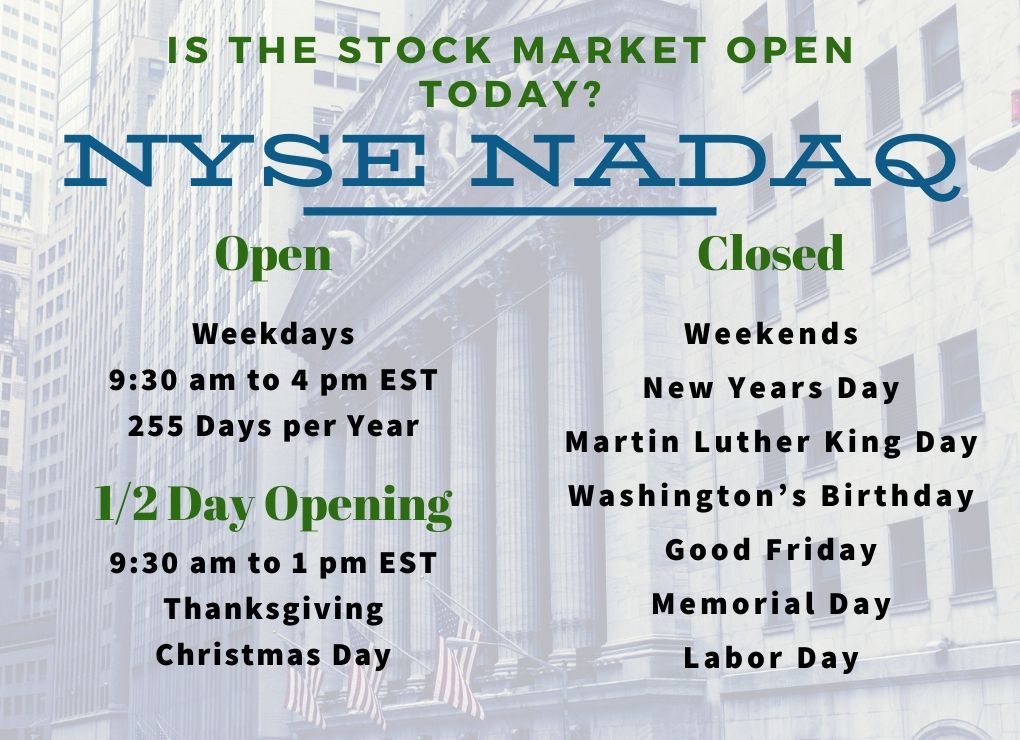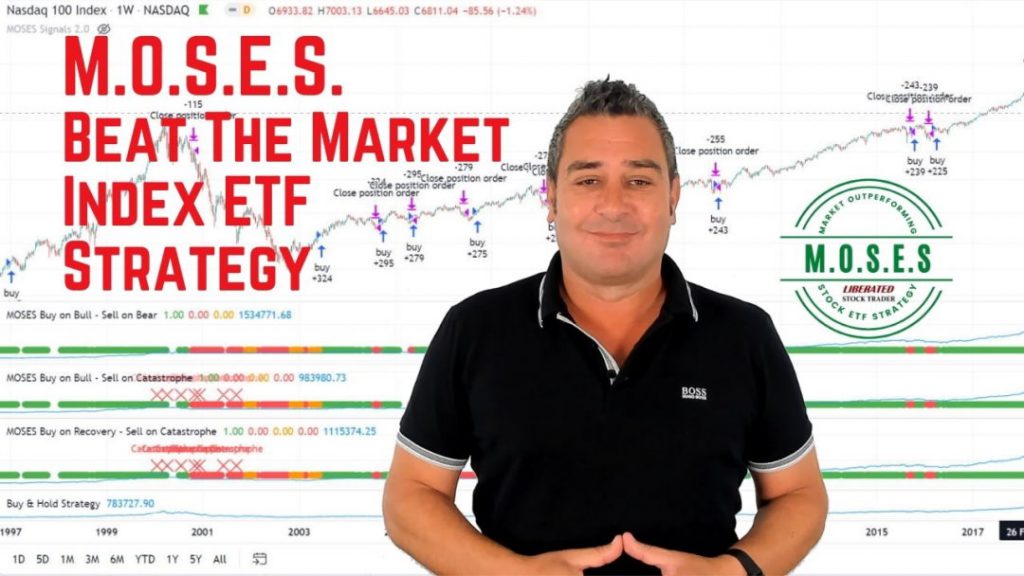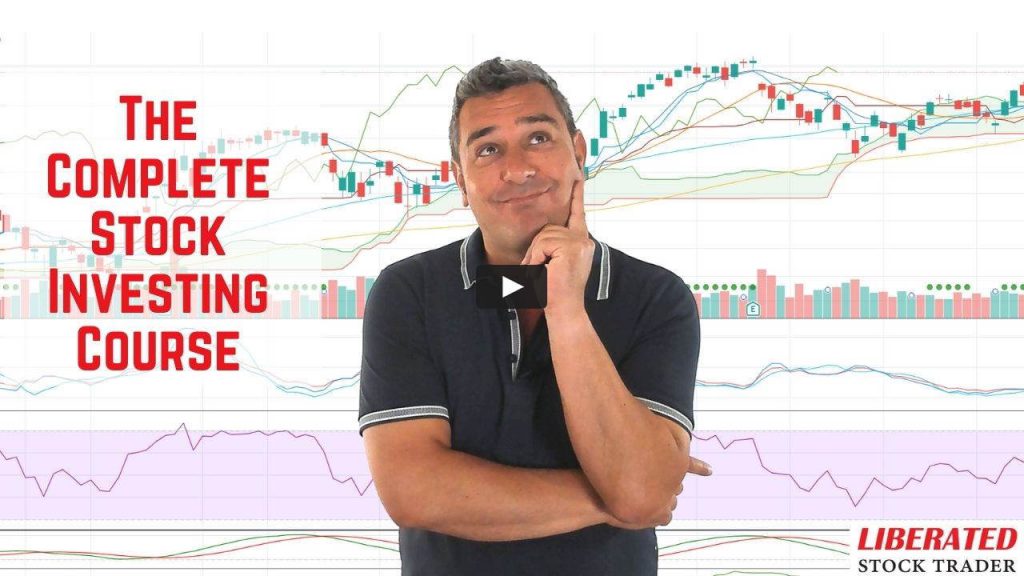
Is the Stock Market Open Today?
Yes, the NYSE & NASDAQ Stock Exchanges are open today, except for weekends, New Year’s Day, Martin Luther King Day, Washington’s Birthday, Good Friday, Memorial Day, and Labor Day. On Thanksgiving & Christmas Day, the markets close at 1 pm EST. The U.S. stock markets are open 255 days yearly from 9:30 am to 4 pm EST.
Holiday Shut Downs for the NASDAQ & New York Stock Exchange 2024-2026
| Holiday | 2024 | 2025 | 2026 |
| New Years Day | January 1, 2024 | January 1, 2025 | January 1, 2026 |
| Martin Luther King, Jr. Day | January 15, 2024 | January 20, 2025 | January 19, 2026 |
| Washington’s Birthday | February 19, 2024 | February 17, 2025 | February 16, 2026 |
| Good Friday | March 29, 2024 | April 18, 2025 | April 3, 2026 |
| Memorial Day | May 27, 2024 | May 26, 2025 | May 25, 2026 |
| Juneteenth National Independence Day | June 19, 2024 | June 19, 2025 | June 19, 2026 |
| Independence Day | July 4, 2024* | July 4, 2025* | July 3, 2026* |
| Labor Day | September 2, 2024 | September 1, 2025 | September 7, 2026 |
| Thanksgiving Day | November 28, 2024 | November 27, 2025 | November 26, 2026 |
| Christmas Day | December 25, 2024 | December 25, 2025 | December 25, 2026 |
Source: * Half Day.
You want to be a successful stock investor but don’t know where to start.
Learning stock market investing on your own can be overwhelming. There’s so much information out there, and it’s hard to know what’s true and what’s not.
Liberated Stock Trader Pro Investing Course
Our pro investing classes are the perfect way to learn stock investing. You will learn everything you need to know about financial analysis, charts, stock screening, and portfolio building so you can start building wealth today.
★ 16 Hours of Video Lessons + eBook ★
★ Complete Financial Analysis Lessons ★
★ 6 Proven Investing Strategies ★
★ Professional Grade Stock Chart Analysis Classes ★
New York Stock Exchange (NYSE) Detailed Holidays & Opening Times
The largest Stock Exchange in the world with a market capitalization of $21 Trillion.
Details & Opening Times
- Location: New York City
- Indices Served: Standard & Poors (S&P 500), (S&P400), Dow Jones (DJ30, DJ20)
- Opening Hours: Weekdays U.S. Eastern 9:30 am to 4 pm
- Weekends – Closed
NASDAQ Exchange Detailed Holidays & Opening Times
The second-largest Stock Exchange in the world.
Details & Opening Times
- Location: New York City
- Indices Served: NASDAQ 100, NASDAQ Composite
- Opening Hours: Weekdays U.S. Eastern 9:30 am to 4 pm
- Weekends – Closed
Frequently Asked Questions
What Time Does the Stock Market Open?
The US stock markets open from 9:30 am to 4 pm Monday through Friday Eastern Standard Time (EST). Notable exceptions to this rule are New Year's Day, MLK Day, Presidents Day, Good Friday, Memorial Day, Juneteenth, Independence Day, Labor Day, Thanksgiving, and Christmas Day.
What time does the stock market open in Texas?
In Texas, the US stock markets open from 8:30 am to 3 pm Monday through Friday Central Standard Time (CST). In west Texas counties following Mountain Standard Time (MST), the stock market opens at 7:30 am and closes at 2 pm.
What time does the stock market open in California?
In California and Washington State, the US stock markets open from 6:30 am to 1 pm Monday through Friday Pacific Standard Time (PST).
Is the Stock Market Open on Columbus Day?
Yes, the US stock markets are open on Columbus Day. In the US, Columbus day is a Federal Holiday, meaning only Federal employees and bank staff get the day off.
Is the Stock Market Open on Veterans Day?
Yes, the US stock markets are open on Veterans Day. Despite Veterans day being a federal and bank holiday, the stock market remains open.
Is the Stock Market Open on Presidents Day/Washington’s Birthday
The stock market is always closed on Presidents Day/Washington's Birthday. The next Presidents day is on Monday, February 19, 2024.
Is the Stock Market Open on Martin Luther King (MLK) Day?
No, the US stock market is closed yearly on Martin Luther King Day (MLK). The next stock market closure for MLK Day is on Monday, January 15, 2024.
Is the Stock Market Open on Juneteenth?
No, the stock market is always closed on Juneteenth to commemorate the emancipation of enslaved African Americans. The next stock market closure for Juneteenth National Independence day is Monday, June 19, 2023, and Wednesday, June 19, 2024.
Is the Stock Market Open on Labor Day?
No, the US stock market is always closed on Labor Day. To commemorate the American labor movement, Labor day is a major US holiday, and the stock market is closed. Labor Day stock market closure will occur on Monday, September 4, 2023, and Monday, September 2, 2024.
Is the Stock Market Open on Independence Day?
Despite Independence Day being a major Federal and Public holiday in the USA, the US stock market is open. The NASDAQ and NYSE are open for a half-day, closing at 1 pm EST if independence day falls on a weekday.
Is the Stock Market Open on Good Friday?
The US and European stock markets always close on Good Friday. Good Friday is a long-standing religious Christian holiday. The next stock market Good Friday closures are Friday, April 7, 2023, and Friday, March 29, 2024
What Time do the US Markets Close?
The US Stock markets close at 4 pm (EST), 3 pm (CST), and 1 pm (PST) every weekday. Notable exceptions are New Year's Day, MLK Day, Presidents Day, Good Friday, Memorial Day, Juneteenth, Independence Day, Labor Day, Thanksgiving, and Christmas Day.
What time does the stock market open in central time?
In Central Standard Time (CST), the US stock markets open from 8:30 am to 3 pm Monday through Friday. CST states include Alabama, Arkansas, Illinois, Iowa, Louisiana, Minnesota, Missouri, Mississippi, Oklahoma, Wisconsin, and most of Texas.
Is the stock market open Monday?
The stock market is usually open every Monday except for Monday, May 29, June 19, September 4, and Monday, December 25, 2023. In 2024 Monday closures will be Monday, January 1, January 15, February 19, May 27, and September 2, 2024.
Is the stock market open on Black Friday?
Yes, the stock market is always open on Black Friday, but it closes early at 1 pm (EST). Black Friday is not a public or federal holiday in the US or anywhere else. Black Friday is a marketing strategy to boost sales in a particularly dull part of the retailing year.
Is the stock market open on Memorial Day?
Out of respect for fallen US military personnel, the US stock markets are always closed on Memorial Day. Memorial day is always the last Monday of May, and the next US stock market Memorial Day closures will be Monday, May 29, 2023, and Monday, May 27, 2024.
Is the stock market open on weekends?
All stock markets in the USA and Europe are closed on weekends without exception. As a rule, stock markets only open on weekdays and never at weekends.
Is the stock market closed on Veterans Day?
The stock market will remain open if Veterans Day is on a weekday. The stock market does not close on veterans day. If Veterans day is on the weekend, the stock market will be closed. The next Veterans Day is November 11.
What time does the NYSE open?
The New York Stock Exchange (NYSE) is open from 9:30 am to 4 pm Monday through Friday Eastern Standard Time (EST). Except for New Year's Day, MLK Day, Presidents Day, Good Friday, Memorial Day, Juneteenth, Independence Day, Labor Day, Thanksgiving, and Christmas Day.
Is the stock market closed on Columbus Day?
No, the stock market is not closed on Columbus Day. Columbus Day is a Federal holiday in the USA, meaning only Federal employees and bank staff get the day off. The stock market remains open.
What are the main Wall Street Holidays?
Wall Street has ten major holiday closures yearly: New Year's Day, MLK Day, Presidents Day, Good Friday, Memorial Day, Juneteenth, Independence Day, Labor Day, Thanksgiving, and Christmas Day.
Is the stock market open on Saturday?
No, the stock market is never open on Saturday. Major stock markets in the USA and Europe are always closed on Saturday and Sunday.
Is the stock market open the day after Thanksgiving?
The day after Thanksgiving is known now as Black Friday, and the stock market is always open on Black Friday, but it closes early at 1 pm (EST).
European Stock Market Opening Times
- Location: Amsterdam, Brussels, Lisbon, London, Paris
- Indices Served: French CAC 40, Iberian Index, BEB 20, AMX, AEX, LC100 Europe, PSI 20
- Opening Hours: Weekdays Central European Time (UTC+1) 08:00 to 16:30
- Weekends – Closed
Holiday Shut Downs Euronext Exchanges 2024
| EURONEXT HOLIDAYS | PARIS | MILAN | BRUSSELS | LISBON | AMSTERDAM | DUBLIN | OSLO |
| Monday, January 1 (New Year’s Day) | Closed | Closed | Closed | Closed | Closed | Closed | Closed |
| Tuesday, January 2, 2024 (Substitute for New Year’s Day) | Open | No After Hours Trading | Open | Open | Open | Open | Open |
| Wednesday, January 3 – Friday, January 5, 2024 | Open | No After Hours Trading | Open | Open | Open | Open | Open |
| Wednesday, March 27, 2024 (Half trading day, Wednesday before Easter) | Open | Open | Open | Open | Open | Open | Half Day |
| Thursday, March 28, 2024 (Maundy Thursday) | Open | No After Hours Trading | Open | Open | Open | Open | Closed |
| Friday, March 29, 2024 (Good Friday) | Closed | Closed | Closed | Closed | Closed | Closed | Closed |
| Monday, April 1, 2024 (Easter Monday) | Closed | Closed | Closed | Closed | Closed | Closed | Closed |
| Thursday, April 25, and Friday, April 26, 2024 | Open | No After Hours Trading | Open | Open | Open | Open | Open |
| Wednesday, May 1, 2024 (Labour Day) | Closed | Closed | Closed | Closed | Closed | Closed | Closed |
| Monday, May 6 (Irish May Bank Holiday) | Open | Open | Open | Open | Open | Closed | Open |
| Thursday, May 9, 2024 (Ascension Day) | Open | Open | Open | Open | Open | Open | Closed |
| Friday, May 17, 2024 (Constitution Day) | Open | Open | Open | Open | Open | Open | Closed |
| Monday, May 20, 2024 (Whit Monday) | Open | Open | Open | Open | Open | Open | Closed |
| Thursday, August 15, 2024 (Ferragosto) | Open | Closed | Open | Open | Open | Open | Open |
| August 2024 (Milan – All business days) | Open | No After Hours Trading | Open | Open | Open | Open | Open |
| Friday, November 1 2024 | Open | No After Hours Trading | Open | Open | Open | Open | Open |
| Monday, December 23 2024 | Open | No After Hours Trading | Open | Open | Open | Open | Open |
| Tuesday, December 24 2024 | Half Day | Closed | Half Day | Half Day | Half Day | Half Day | Closed |
| Wednesday, December 25, 2024 (Christmas) | Closed | Closed | Closed | Closed | Closed | Closed | Closed |
| Thursday, December 26 2024 | Closed | Closed | Closed | Closed | Closed | Closed | Closed |
| (St Stephens Day / Boxing | |||||||
| Day) | |||||||
| Friday, December 27, and Monday, December 30, 2024 | Open | No After Hours Trading | Open | Open | Open | Open | Open |
| Tuesday, December 31 2024 | Half Day | Closed | Half Day | Half Day | Half Day | Half Day | Closed |
Invest in yourself! Get all our courses & strategies for 50% off

★ Liberated Stock Trader Pro Stock Investing & Trading Course ★
★ M.O.S.E.S. Market Outperforming ETF Strategy ★
★ LST Beat the Market Stock Picking Strategy ★
★ Exclusive Bonus Course – The Stock Market Crash Detector Strategy ★
★ Fully Guided Videos, eBooks & Lifetime Email Support ★
★ 108 Videos + 3 Full eBooks + 5 Scripts for TradingView & Stock Rover ★
London Stock Exchange (LSE) Opening Times
The sixth-largest Stock Exchange in the world with a market capitalization of $4.3 Trillion.
Details & Opening Times
- Location: City of London
- Indices Served: FTSE 100
- Opening Hours: Weekdays GMT 09:00 to 16:30
- Weekends – Closed
Beat The Market, Avoid Crashes & Lower Your Risks
Nobody wants to see their hard-earned money disappear in a stock market crash.
Over the past century, the US stock market has had 6 major crashes that have caused investors to lose trillions of dollars.

The MOSES Index ETF Investing Strategy will help you minimize the impact of major stock market crashes. MOSES will alert you before the next crash happens so you can protect your portfolio. You will also know when the bear market is over and the new rally begins so you can start investing again.
MOSES Helps You Secure & Grow Your Biggest Investments
★ 3 Index ETF Strategies ★
★ Outperforms the NASDAQ 100, S&P500 & Russell 3000 ★
★ Beats the DAX, CAC40 & EURO STOXX Indices ★
★ Buy & Sell Signals Generated ★
MOSES Helps You Sleep Better At Night Knowing You Are Prepared For Future Disasters


